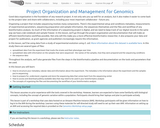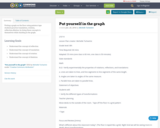
Students will identify the purposes of government contained in the Preamble of the United States Constitution.
- Subject:
- U.S. History
- Material Type:
- Lesson Plan
- Author:
- Michelle Huebel
- MSDE Admin
- Date Added:
- 08/15/2018

Students will identify the purposes of government contained in the Preamble of the United States Constitution.

User Scenarios and Use Cases for Tools developed for the Preferences for Global Access Research and Design Project.

This book serves to fill a critical gap in existing healthcare education resources, by raising healthcare professional and healthcare educators’ awareness of uncertainty tolerance. This handbook explores the impact health professions education (and educators) can have on the future healthcare workforce’s ability to manage uncertainty effectively, and provides practical approaches (including exemplar curricular templates) for supporting this essential workplace-ready, transferable attribute.

State Approaches to OER/No Cost/Low Cost Course Schedule Designators
Short Description:
The practice of adding either OER or no-cost/low-cost materials designators in course schedules is on the rise, aiming to give more visibility and transparency to students and administrators as to which courses offer these more affordable options. Few formal reports have been published on the implementation and impact of OER/No Cost/Low Cost designations integrated into course schedules at colleges and universities. This booklet aims to lessen the literature gap by providing written accounts of the course marking drivers, implementation strategies, challenges, and lessons learned presented by panelists at the 16th Annual Open Education Conference in Phoenix, Arizona, in October 2019.
Word Count: 8321
(Note: This resource's metadata has been created automatically by reformatting and/or combining the information that the author initially provided as part of a bulk import process.)

This toolkit was developed as part of the Primary Source Project. In creating the toolkit, ISKME collaborated with 12 educators from 8 different states, who possessed varied subject area expertise. The toolkit is a sequenced pathway for selecting informational and non-fiction literary texts, and creating integrated wraparound lessons that meet the Common Core State Standards, as well as the C3 Social Studies Standards and the Next Generation Science Standards.

The Process of Science Companion is composed of the following four books: Science Communication; Scientific Group Collaboration; Data Analysis, Statistics, and Experimental Design; Tools and Techniques. These resources provide support for students doing independent research.

Data Carpentry Genomics workshop lesson to learn how to structure your metadata, organize and document your genomics data and bioinformatics workflow, and access data on the NCBI sequence read archive (SRA) database. Good data organization is the foundation of any research project. It not only sets you up well for an analysis, but it also makes it easier to come back to the project later and share with collaborators, including your most important collaborator - future you. Organizing a project that includes sequencing involves many components. There’s the experimental setup and conditions metadata, measurements of experimental parameters, sequencing preparation and sample information, the sequences themselves and the files and workflow of any bioinformatics analysis. So much of the information of a sequencing project is digital, and we need to keep track of our digital records in the same way we have a lab notebook and sample freezer. In this lesson, we’ll go through the project organization and documentation that will make an efficient bioinformatics workflow possible. Not only will this make you a more effective bioinformatics researcher, it also prepares your data and project for publication, as grant agencies and publishers increasingly require this information. In this lesson, we’ll be using data from a study of experimental evolution using E. coli. More information about this dataset is available here. In this study there are several types of files: Spreadsheet data from the experiment that tracks the strains and their phenotype over time Spreadsheet data with information on the samples that were sequenced - the names of the samples, how they were prepared and the sequencing conditions The sequence data Throughout the analysis, we’ll also generate files from the steps in the bioinformatics pipeline and documentation on the tools and parameters that we used. In this lesson you will learn: How to structure your metadata, tabular data and information about the experiment. The metadata is the information about the experiment and the samples you’re sequencing. How to prepare for, understand, organize and store the sequencing data that comes back from the sequencing center How to access and download publicly available data that may need to be used in your bioinformatics analysis The concepts of organizing the files and documenting the workflow of your bioinformatics analysis

This resource guide was created as an accompaniment for a hands-on, three-hour workshop on the basics of online privacy and security in a Canadian context. The workshop is designed for young adults and adults with basic computer/phone/online skills: we assume participants know how to get online, how to do basic internet searches, and how to install simple tools and software on their devices. The workshop is most often taught in public library settings.
This guide provides:
- an overview of security and privacy
- information about key privacy technologies including ad blockers, tracking detection, basic encryption tools, secure messaging tools and password management
- some "advanced" information on Virtual Private Networks (VPNs), Tor, private email services, and more
- instructional guides for basic tools, customized for Windows, MacOS, Android, iOS and ChromeOS devices

High School students will learn more about protein in the body and why it is essential. They will also analyze complete vs. incomplete proteins and making healthy protein choices.

This oral communication content includes several types of common college-level presentations including an informative speech, visual aid presentation, and Monroe's Motivated Sequence persuasive speech. All of the presentations are for critique and compatible with rubrics that examine basic elements of public speaking. All presentations in this series were delivered by student volunteers as part of a technology fellowship project at the University of Alaska Anchorage. Please note that student presenter first names were included as a way to promote classroom climate and respect when critiquing. It is found that students are more likely to critique in a respectful manner when the example speech presenter is named.

Pulling Together: A guide for Indigenization of post-secondary institutions. A professional learning series.
Word Count: 15801
(Note: This resource's metadata has been created automatically as part of a bulk import process by reformatting and/or combining the information that the author initially provided. As a result, there may be errors in formatting.)

Putting a graph on the floor using painters tape students practice translation, rotation, reflection,dilation, by doing these concepts to themselves while standing in the graph.

Too many of our students are physically unable to perform movements that should be simple for their age group. This workout is designed to challenge students out of their fitness comfort zone without deterring them from wanting to live a life of good health and fitness.

Red Seal Landscape Horticulturist Identify Plants and Plant Requirements is an adaptation of KPU HORT 1155 Introduction to Plant Materials Lecture Notes. This first edition supports student achievement of the Level 1 and 2 learning goals for Red Seal Landscape Horticulturist Line F2.

Line F Apply Horticultural Practices: F2 - Level 1, 2, 3 and 4
Short Description:
Red Seal Landscape Horticulturist Identify Plants and Plant Requirements is an adaptation of KPU HORT 1155 Introduction to Plant Materials Lecture Notes. This first edition supports student achievement of the Level 1, 2, 3 and 4 learning goals for Red Seal Landscape Horticulturist Line F2.
Long Description:
Red Seal Landscape Horticulturist Identify Plants and Plant Requirements is an adaptation of KPU HORT 1155 Introduction to Plant Materials Lecture Notes. It is an editable, open access learning resource with interactive web based experiences customized for horticulture students studying plant identification.
This first edition supports student achievement of the Level 1, 2, 3 and 4 learning goals for Red Seal Landscape Horticulturist Line F2: Identify plant and plant requirements for a range of plants commonly used in horticulture Employ correct naming and plant identification terminology Identify morphological characteristics, growing requirements, use and availability Use a dichotomous key for plant identification Explain plant hardiness Identify weedy and invasive plants Identify plant and plant requirements for a range of woody and non-woody plants Use botanical terms to identify and describe plants Identify and describe plants according to cultural and maintenance requirements Recognize plants suitable for common tropical, floral and interior landscape situations Identify plants suitable for planting in difficult situations Describe native plants common to the horticulture industry Describe seasonal plants common to the horticulture industry in BC Describe plants suitable for green infrastructure projects Describe plants suitable for edible landscapes
Word Count: 24488
Included H5P activities: 94
ISBN: 978-1-77420-083-4
(Note: This resource's metadata has been created automatically by reformatting and/or combining the information that the author initially provided as part of a bulk import process.)

Line F Apply Horticultural Practices: F2 - Level 3 and 4
Short Description:
Red Seal Landscape Horticulturist Identify Plants and Plant Requirements is an adaptation of KPU HORT 1155 Introduction to Plant Materials Lecture Notes. This edition supports student achievement of the Level 3 and 4 learning goals for Red Seal Landscape Horticulturist Line F2.
Long Description:
Red Seal Landscape Horticulturist Identify Plants and Plant Requirements is an editable, open access learning resource with interactive web based experiences customized for horticulture students studying plant identification.
This edition supports student achievement of the Level 3 and Level 4 learning goals for Red Seal Landscape Horticulturist Line F2: Identify plant and plant requirements for a range of woody and non-woody plants Use botanical terms to identify and describe plants Identify and describe plants according to cultural and maintenance requirements Recognize plants suitable for common tropical, floral and interior landscape situations Identify plants suitable for planting in difficult situations Describe native plants common to the horticulture industry Describe seasonal plants common to the horticulture industry in BC Describe plants suitable for green infrastructure projects Describe plants suitable for edible landscapes
Word Count: 10476
Included H5P activities: 72
ISBN: 978-1-989864-18-0
(Note: This resource's metadata has been created automatically as part of a bulk import process by reformatting and/or combining the information that the author initially provided. As a result, there may be errors in formatting.)

Students perform a variety of activities to equal 100 to celebrate the 100th day of school.

In this lesson, the Electric Slide Line Dance is introduced. The steps are broken down and students get a feel for the rhythm of the music.

Exercises/Workouts to do from home.

**For remote learning: Students will pick between two dances to practice during the week:German Clap Dance (in this lesson) or Line Dance**For classroom: Teacher will focus on this dance all week.In this lesson, the German Clap Dance is introduced. The steps are broken down and students get a feel for the rhythm of the music.